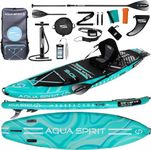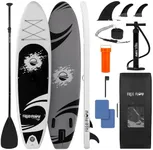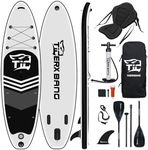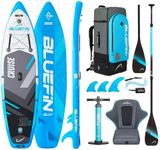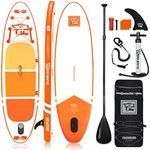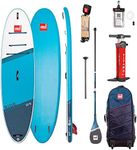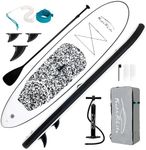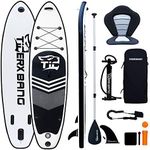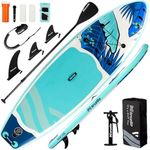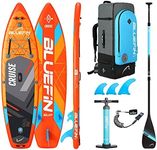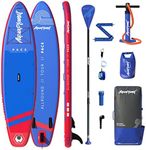Buying Guide for the Best Inflatable Paddleboards
Choosing the right inflatable paddleboard (iSUP) can greatly enhance your paddling experience, whether you're a beginner or an experienced paddler. The key is to understand the different specifications and how they align with your needs and preferences. By focusing on the right specs, you can ensure that you get a paddleboard that suits your style, skill level, and the type of water you'll be paddling on.LengthThe length of an inflatable paddleboard affects its speed, stability, and maneuverability. Shorter boards (under 10 feet) are more maneuverable and are great for surfing or for kids. Medium-length boards (10-12 feet) offer a balance of speed and stability, making them ideal for all-around use and beginners. Longer boards (over 12 feet) are faster and track better, making them suitable for long-distance paddling and racing. Choose a length based on your intended use: shorter for agility, medium for versatility, and longer for speed.
WidthWidth impacts the stability and speed of the paddleboard. Wider boards (over 32 inches) provide more stability, making them ideal for beginners, yoga, or carrying extra gear. However, they can be slower and less responsive. Narrower boards (under 30 inches) are faster and more agile but require better balance, making them suitable for experienced paddlers or those looking to race. If you're new to paddleboarding or plan to use the board for activities like yoga, opt for a wider board. For speed and performance, a narrower board is preferable.
ThicknessThe thickness of an inflatable paddleboard affects its buoyancy and rigidity. Thicker boards (6 inches) are more rigid and can support more weight, making them suitable for heavier paddlers or those carrying extra gear. Thinner boards (4-5 inches) are lighter and can be easier to handle but may not be as stable or supportive for heavier users. Consider your weight and the type of activities you'll be doing. If you need more support and stability, go for a thicker board. For lighter paddlers or those prioritizing ease of transport, a thinner board may be sufficient.
VolumeVolume, measured in liters, indicates the board's buoyancy and how much weight it can support. Higher volume boards can support more weight and are generally more stable, making them suitable for beginners, larger paddlers, or those carrying extra gear. Lower volume boards are less buoyant and more suited to lighter, more experienced paddlers. To choose the right volume, consider your weight and any additional gear you'll be carrying. Ensure the board's volume can comfortably support your weight for a stable and enjoyable paddling experience.
Weight CapacityWeight capacity is the maximum weight a paddleboard can support while maintaining optimal performance. Exceeding this limit can affect the board's stability and maneuverability. It's important to choose a board with a weight capacity that exceeds your body weight plus any additional gear or passengers. For example, if you weigh 180 pounds and plan to carry 20 pounds of gear, look for a board with a weight capacity of at least 200 pounds. This ensures the board remains stable and performs well on the water.
Construction and MaterialThe construction and material of an inflatable paddleboard determine its durability, rigidity, and overall performance. High-quality iSUPs are typically made from military-grade PVC with drop-stitch construction, providing excellent durability and rigidity. Some boards may have additional layers or reinforcements for extra strength. When choosing a board, consider the quality of the materials and construction, especially if you plan to use it frequently or in rough conditions. A well-constructed board will last longer and provide a better paddling experience.
FinsFins affect the tracking and stability of the paddleboard. Most iSUPs come with a three-fin setup (one large center fin and two smaller side fins) for better stability and tracking. Some boards have removable or adjustable fins, allowing you to customize the setup based on your needs. For straight-line paddling and stability, a larger center fin is beneficial. For maneuverability, especially in surf, smaller side fins are useful. Consider the type of paddling you'll be doing and choose a fin setup that enhances your board's performance in those conditions.
AccessoriesAccessories can enhance your paddleboarding experience and include items like paddles, pumps, leashes, and carrying bags. High-quality paddles are lightweight and adjustable, making them easier to use and more comfortable. A good pump will make inflating your board quicker and easier. Leashes are essential for safety, keeping you connected to your board. Carrying bags make transporting and storing your board more convenient. When choosing a paddleboard, consider the quality and type of accessories included, as they can add value and improve your overall experience.
